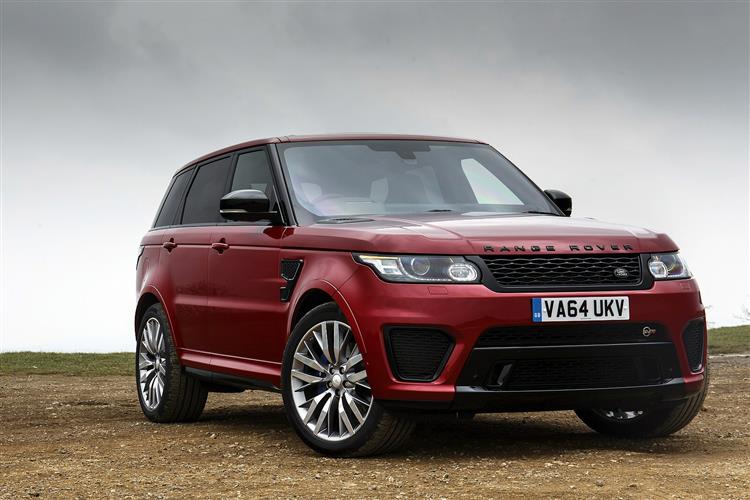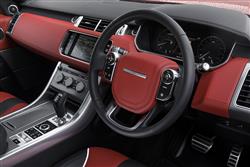SPORT FOR ALL (some text hidden) --NONE--
By Jonathan Crouch
Introductionword count: 63
Bigger, lighter and sharper in its reactions, the second generation Range Rover Sport came of age, frightening German luxury SUV rivals by at last matching them on-tarmac whilst still obliterating them off road. No longer a dressed-up Discovery, it shares plenty with the fully fledged limousine-like Range Rover but is able to bring much of that car's high technology to a wider audience.
Modelsword count: 25
5dr Luxury SUV (3.0-litre TDV6 diesel, 3.0-litre SDV6 diesel, 3.0-litre SDV6 diesel Hybrid, 4.4-litre SDV8 diesel, 5.0-litre V8 petrol [HSE, HSE Dynamic, Autobiography Dynamic, SVR])
Historyword count: 410
Here's a car that claims to be able to do. well, almost everything. It'll cruise on the autobahn at 130mph, ford rivers in the Serengeti, take a family of seven on holiday and slip you down to the shops. It's affordable to run, rewarding to drive and looks dynamic and stylish. There has to be a catch doesn't there? Time to check out earlier versions of the second generation Range Rover Sport as a used car buy. Ah yes, the Range Rover Sport. A car that in its original guise was neither a Range Rover or 'sporty'. In fact, it was based almost entirely on the brand's sensible Discovery model and, thanks to that car's practical ladder frame chassis, as about as dynamic to drive. Still, the smarter set of clothes did the trick and for most of its life between 2005 and 2012, the 'Sport' was Solihull's best seller. There were, it turned out, a vast number of potential buyers who liked the idea of a Range Rover but either couldn't afford one or wanted something a bit sportier. Something like this in other words, the car the concept always promised but never quite delivered. Appropriately, its very existence was at last properly inspired - and in many ways completely made possible - by the fully-fledged Range Rover. Back in 2012, that car was completely redeveloped in fourth generation form with aluminium underpinnings, sharper handling and hybrid power, engineering eagerly seized upon by the Range Rover Sport development team in their quest to at last be able to offer a credibly sporting SUV rival to cars like the Porsche Cayenne and the BMW X5. The result was the MK2 model Range Rover Sport, launched in 2013. German competitors of course, don't have to blend in unrivalled off road excellence with their back road blasting. They don't have to be automotive swiss army knives - all things to all people - in quite the same way. So, burdened with such expectations, how can this Range Rover - how can any Range Rover - take them on at their own game? That's the issue this car has always faced. A 542PS 'SVR' version of the 5.0-litre petrol V8 model was introduced in 2014. And shortly after, the 292PS SDV6 diesel engine was uprated to 306PS. This second generation model was lightly updated for the 2017 model year, but it's the earlier 2013 to 2016 versions we're going to look at here.
What You Getword count: 1100
Imagine you were toned, fit - and nearly 20% lighter. How would you look? Sharper? Smarter? Younger? As indeed this second generation Range Rover Sport model does in comparison to its boxy, heavy predecessor. The faster windscreen angle, streamlined profile and sloping roofline make it sleek and contemporary - as it should be, a Range Rover Sport for a new era. But recognisably a Range Rover Sport: the clamshell bonnet, 'floating' roof, powerful wheelarches and side fender vents that define this model are all present and correct. Up close, the 'S' in 'SUV' is further emphasised by the high beltline, short overhangs and distinctive silhouette. At the front, the slimmer LED lights and sculpted corners flank a classic two-bar rearward-sloping front grille executed to a theme reflected by the twin strakes of the fender vents. And there are bold trapezoidal shapes to house the central bumper beam and skidplate. A trapezoidal theme that's repeated at the rear where the skidplate is flanked by large twin exhausts. Not a car to be trifled with then. It's a much more spacious thing than the MK1 version - though only 62mm longer - which makes it all the more surprising that the Solihull engineers have been able to make it so much lighter. A modified version of the fully-fledged Range Rover's aluminium monocoque chassis accounts for most of the 420kgs that have been trimmed from a kerb weight that in MK2 form, crucially, pitches this car in at just over two tones, rather than just under three. Back in 2013, this design's aluminium approach represented a trailblazing one in this class but it's not enough to make this Sport a car that could be in any way described as 'lightweight' in the luxury SUV segment. Still, the fact that it's no heavier than rivals like Porsche's Cayenne and BMW's X5, cars that don't need to carry around such sophisticated bulky all-wheel drive hardwear, has to be seen as quite an achievement. And inside? Well, you'd be disappointed if you didn't have to climb up into a Range Rover - that's part of its appeal - though older folk can with this Sport model ease the process by selecting a lower 'Access' mode on variants fitted with air suspension. Once installed in the generously side bolstered seats though, there's no mistaking that you're at the wheel of this British institutional model's younger, slightly smaller and much sportier twin. For a start, you're sat a tad lower than you would be in a Range Rover, plus the more compact thicker-rimmed wheel's smaller, the upright gearstick more purposeful and the centre console higher. Perhaps that last point's the most significant as it positions the controls closer to you, creating a cocooning feel for front seat occupants. Racy then - but still regal too. You're surrounded by simply acres of expensive materials. Plenty of hi-tech too, some of it more effectively presented than others. Hard to dislike is the 12.3-inch TFT instrument screen offered on plusher versions that comes instead of the conventional dials you get on more affordable models. To replace these, the TFT approach offers lifelike digital facsimilies of the usual rev and speedo gauges, this just one of a range of customisable displays the panel can offer to suit your requirements. Off road for example, the rev counter can move aside in favour of a graphical drivetrain that shows which wheels are being driven, which diffs are locked and much more. In fact, the virtual screen can be customised to show anything from the outside temperature to navigation information, telephone system settings or wheel articulation. Less clear and intuitive are the buttons on the steering wheel which control a range of electronic options in the centre dash display. You'll need to spend some time with your nose buried in the instruction manual to figure out both these and the infotainment system, whose screen dominates the centre part of the dash and which, by voice, touch or steering wheel button, marshals everything from sat nav to seat heating, stereo sound to surround cameras. Unfortunately, it requires much familiarisation and, in our opinion, too many button pushes to access some of its many functions: four button presses to turn the heated seats off for example. Some of the stuff it does is pretty smart though. The '4x4 Info' display for example, which shows you the state of play for everything from deactivating diff locks to driving into rivers. And we're always impressed by Jaguar Land Rover's optional 'Dual View' technology which enables this 8-inch screen to simultaneously display a different image to driver and passenger. So at the wheel, you can, say, view the navigation display while your passenger watches a video. Neat. And in the back? Well it's easier to get in to this car than was the case with the MK1 version, thanks to the larger rear door aperture and the lower seating position. And, once inside, you'll find that the significant increase in wheelbase you get in this second generation Sport brings two main advantages with it: more rear seat space and, potentially, more rear seats. Settle yourself in the rear and, if you're familiar with a fully-fledged Range Rover, you'll find that a place in the back of this car is nearly as nice. The reclinable bench (which can be optionally heated and cooled) is wider and more comfortable than before and offers up 24mm more kneeroom. If you've found a variant fitted out with optional third row seating, the middle bench will also feature a mechanism able to slide it back and forth. We should point out that, as you might expect, the extra third row chairs are really only for kids and short journeys. The boot is accessed via an electrically operated tailgate (a one piece hatch rather than the two-piece item you get on a fully-fledged Range Rover). The optional full-sized spare wheel sits beneath the cargo area floor, rather than untidily dangling below the chassis as it did on the MK1 model. Bear in mind that you don't get any sort of spare wheel on a model fitted out with third row chairs - just a tyre repair kit. The cargo space with the middle row seat up is large - rated at 784-litres. That's less than the MK1 model could offer but still about 20% more bootspace than you'd get in rival BMW X5, Mercedes M-Class or Porsche Cayenne competitors. The X5 and the M-Class turn the tables when their rear seats are folded down but this Sport model's 1,761-litre total should be amply adequate for most.
To see the full road test text contact us on 0330 0020 227
Pictures (high res disabled)

.jpg)
|
.jpg)
|
.jpg)
| |||
.jpg)
|
.jpg)
|
.jpg)
| |||

|
Scoring (subset of scores)
Category: Crossover or SUV 4x4s
| Performance | |
| Handling | |
| Comfort | |
| Space | |
| Styling, Build, Value, Equipment, Depreciation, Handling, Insurance and Total scores are available with our full data feed. | |



